
Triple Date chronographs have always been my favorite vintage watches. The most common triple date movement (ie day, date and month) would be the Valjoux 72C and its later incarnation, the Valjoux 730, both traditional column-wheel chronographs, derived from the Valjoux 23 and 72. I tend to prefer the Valjoux 730 over the 72C, as it beats faster at 21,600 bph, and has a glucydur balance, Triovis micro-regulator and thus is inherently a more accurate timekeeper than the V72C, which runs at a leisurely 18,000 bph. Both calibres are equally well made and finished.
These two calibres are probably the most complicated vintage (pre-1970) production chronographs that are available at an affordable price, not counting any watches made by specialist or high-end manufacturers. The most complex version of the Valjoux 72C is the Valjoux 88, which is identical to the Valjoux 72C, but with an extra moonphase complication, and as such is much rarer and substantially higher in price. Unfortunately, I don't have one - yet!
Anyway....having serviced lots of these movements over the years, but never having actually owned one, I decided that now was the time, so onto Ebay I went. As I have spent a considerable amount of time in hospital over the past 9 months, with not much to do but surf the net, Ebay Madness soon took over and before too long, I had bought FIVE of them! Is that going nuts or what! My wife thinks it was all the drugs they have been feeding me that did it!
My first acqusition, a gold filled version of a Valjoux 730, running fine, but awaiting a service anyway:

This is a Stainless Steel version of the Valjoux 730, also awaiting service:
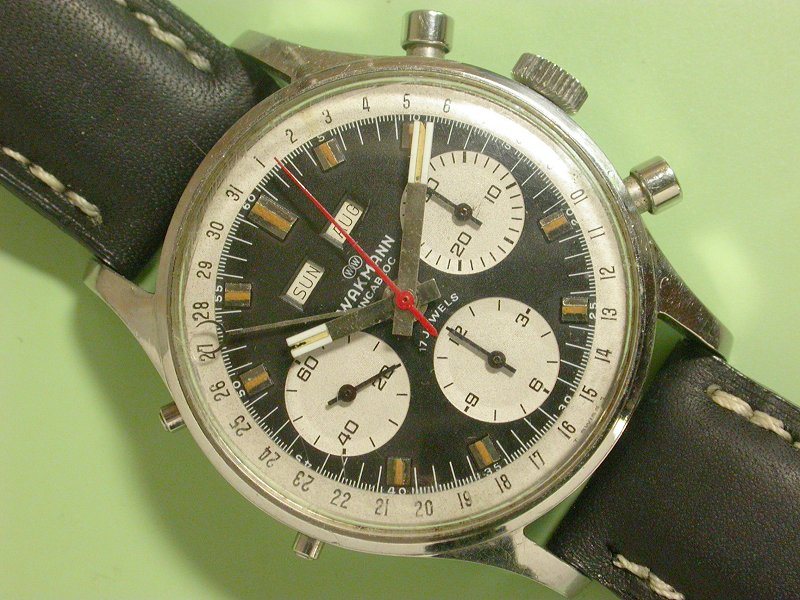
Here are a couple of shots of the Valjoux 730 movement, a superbly designed movement, and very well made and finished. Unfortunately, my photos don't really do justice to the real thing. This is the dial side view:
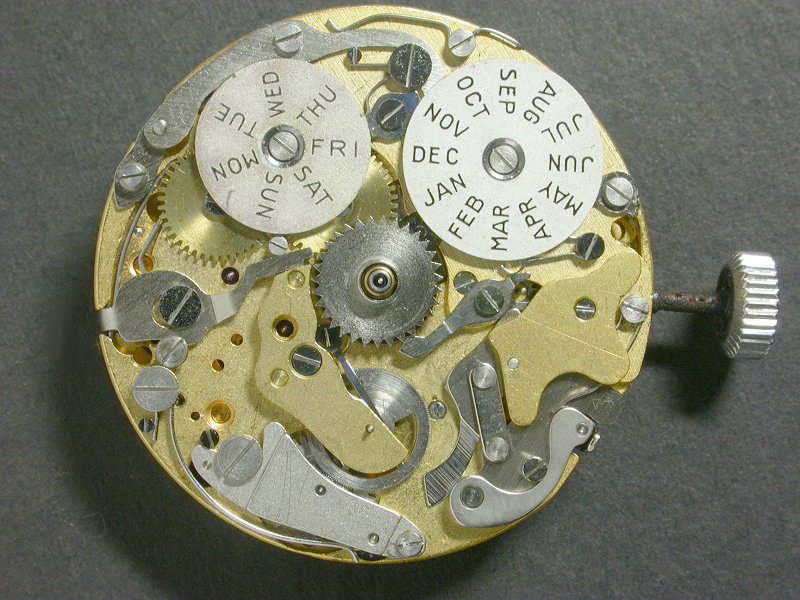
...and this is the back view:
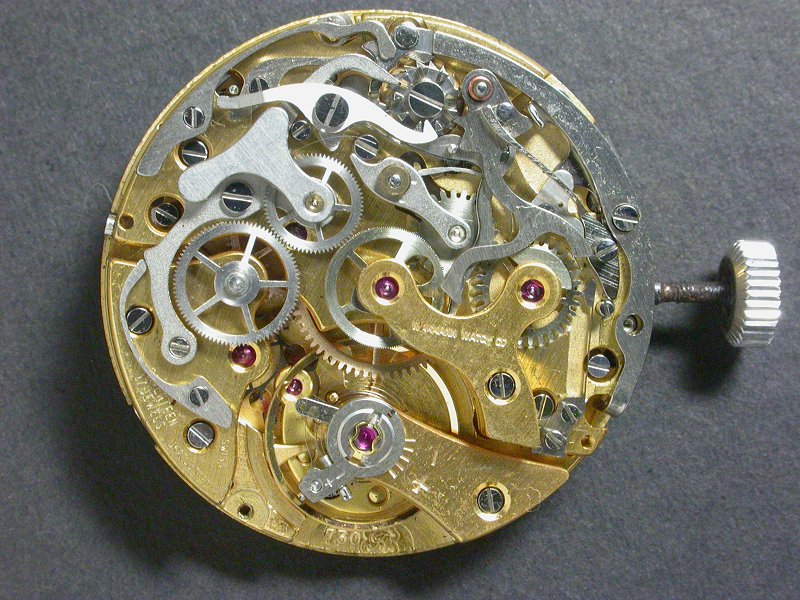
This next pic is of a Valjoux 88 movement (identical to the V72C, but with a few more bits to drive the moonphase wheel. This pic is taken from the Valjoux 72/88 service manual. The Calender discs are not shown for clarity, and the moonphase wheel (the large wheel at bottom center), is shown plain and without the moonphase figure applied to it:
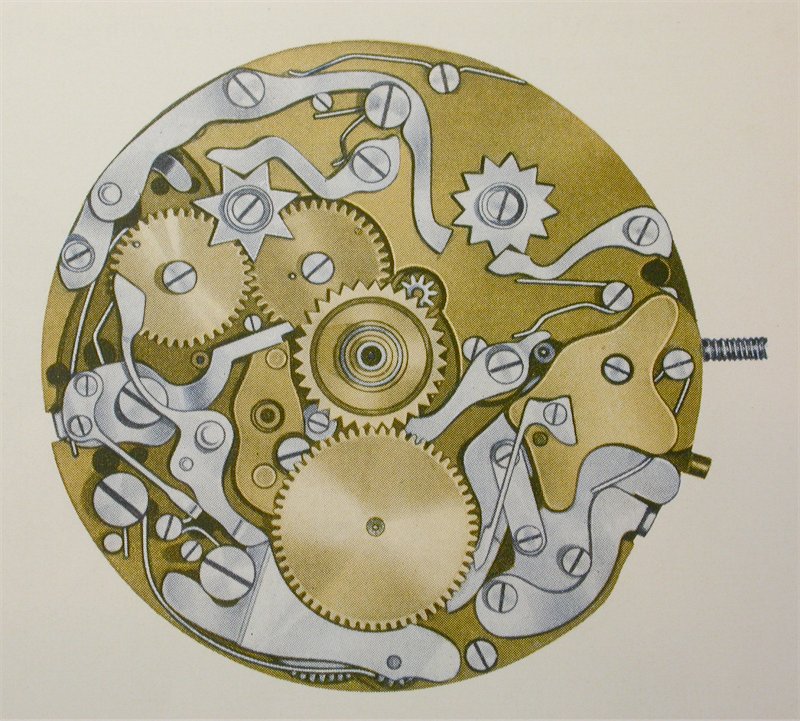
I recently became aware of the Valjoux 7751, a version of the Valjoux 7750 which comes in two variations, one being a triple date 3 register chronograph, with an extra 24 hr hand (day/night indication). The other version includes a moonphase complication. I am guessing that the V7751, with the moonphase complication, would now be the most complex production watch available, (once again not including the specialist limited edition or high end manufacturers) thus surpassing even the Valjoux 88 in complexity. And, fitted with a Glucydur balance, Nivarox hairspring and a beat rate of 28,800 bph, it has the possibility of being a superb timekeeper as well. I just had to get my hands on one of them! So looking around at what was available here in Bangkok, I had the opportunity to buy, at a very good price, a brand new Zeno version of the 7751, with the moonphase complication:
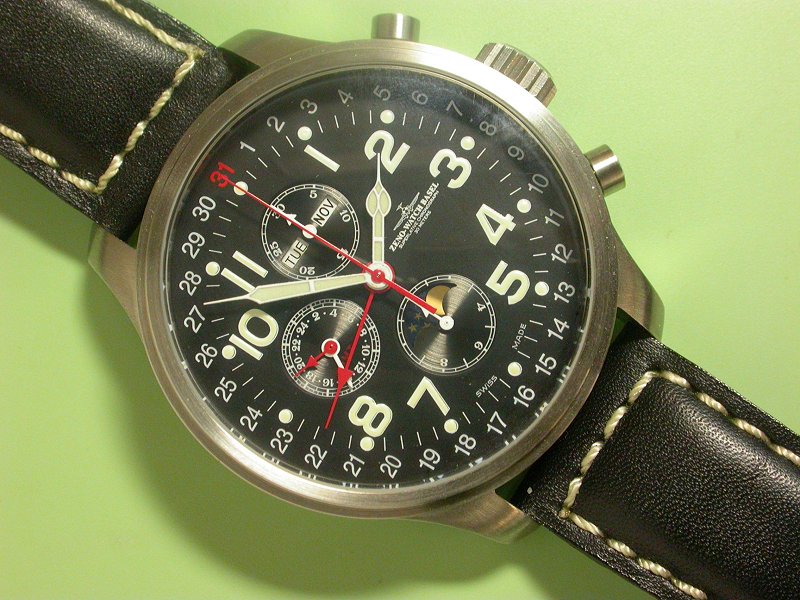
I like big watches, but this one is HUGE! At 47mm across (not including crown), it is 3-5 mm larger in diameter and a few millimeters thicker than the average American 12 Size pocket watch! As you can see in the pic below, it dwarfs the Hamilton 12 sizer! When I first strapped it on my wrist, I was shocked....it made my arm look like a broom stick! But after a few days, I grew to really like its size, and as for telling the time, it is readable from about 10 feet away! Ideal for my 50+ year old eyes! Of course, the chronograph registers are normal size, and I have to squint a little to read them. The Zeno logo (the front view of a jet plane), is a bit of an embarrasment in my opinion, but fortunately it is very small and not very noticeable - as is the ridiculous and meaningless phrase "Superlative Chronometer", which luckily is too small to see without an eyeglass. Rolex take note!
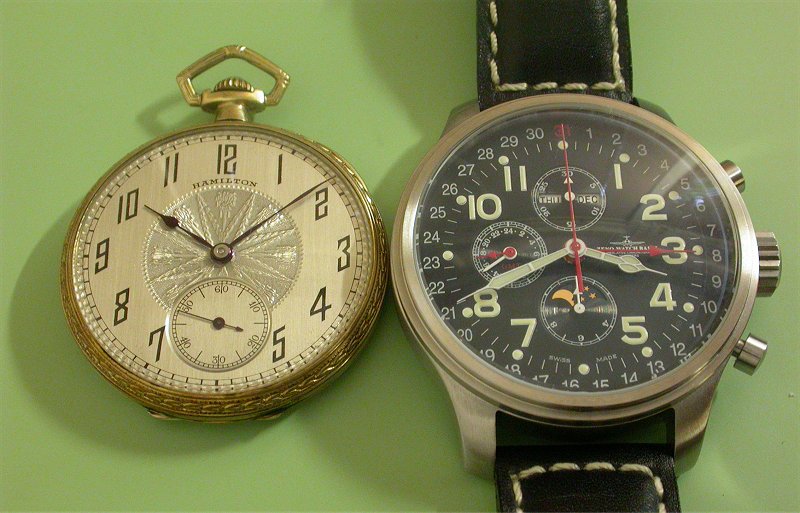
The watch also has a display back, with the visible parts finished to quite a nice standard, and with the Zeno logo engraved on the rotor.
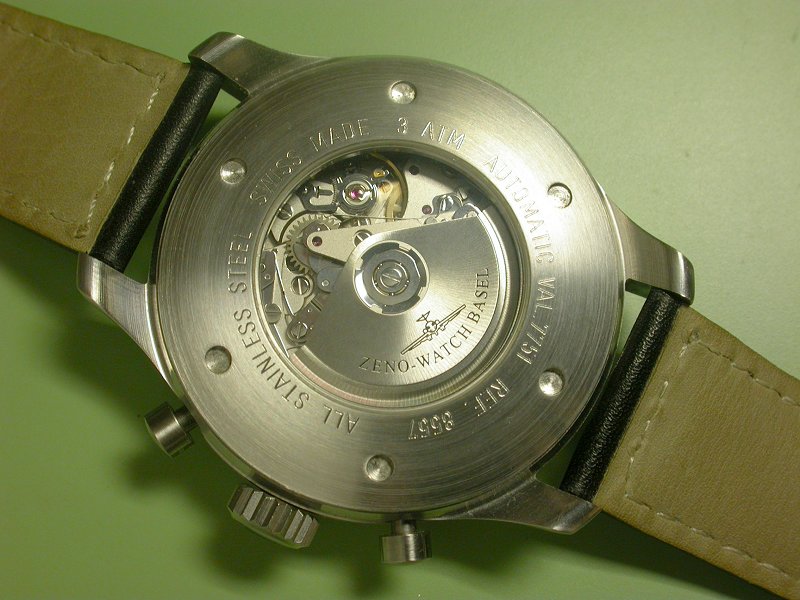
While I may not have been the greatest fan of the Valjoux 7750 when it first appeared many years ago, (in comparing its quality of finish to the ETA/Valjoux calibres pre-1970 or so), I have come to appreciate that it has certainly proven itself in its nearly 30 years of production to be a very reliable and accurate timekeeper, and is relatively easy to service too. Its long production history equates it to being a very well designed movement, and the basic 7750 can be found in dozens of different brands of watches, and in many grades of finish. The IWC variant is probably the best, as they remanufacture and fit many of their own in-house parts to the basic movement. Perhaps the Omega variant the next best, at least as far as decoration and finish goes.
The following two pics show an early production Valjoux 7750 in its original 17 jewel form. There has been no attempt by the manufacturer whatsoever to aesthetically finish the movement. Even the screw heads are in their raw machined state. Perhaps the decision by ETA to do no finishing at all to these movements is a reflection of the "battering" mechanical watches were receiving, as a result of the quartz revolution which was in full swing at that time, when one could buy a cheap watch that kept time as good as any mechanical chronometer. This complete lack of any decoration I believe contributed to the low opinion many watchmakers had of these movements when they first became available. This is a view of the back of the movement:

And here's the dial side:
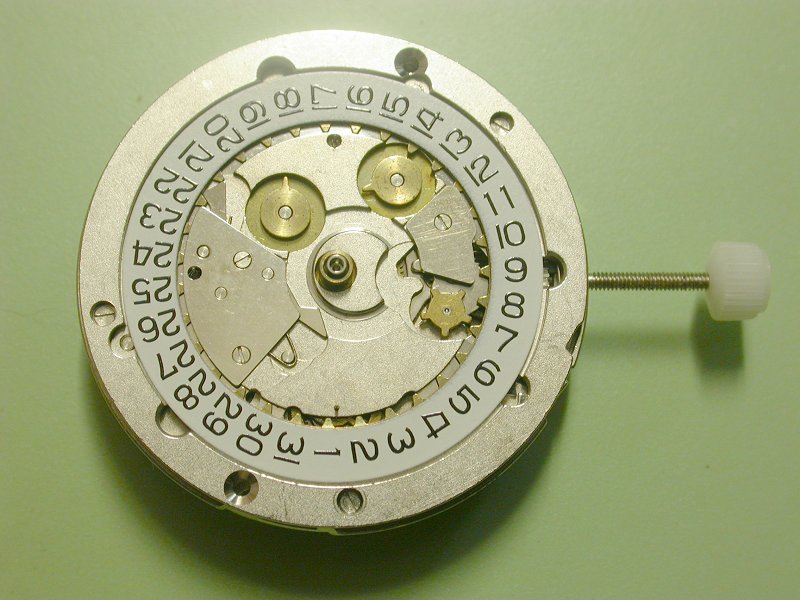
Ironically, this level of finish is quite common these days, and is often seen in cheaper grade movements such as the Seiko 7S26 and even the latest Seiko 6R15. Many people now find it quite acceptable to trade off finish for a more affordable price, especially these days when the performance of even the cheaper movements is very good indeed, thanks to the highly automated manufacturing and assembly methods used now. But, back when the 7750 first appeared in the mid 70's, things were a little different - watchmakers were not used to such low levels of decoration and finish except in the cheapest grades of movements, and definitely not from a revered maker like Valjoux!
Well, since I had eventually managed to overcome my dislike of Valjoux 7750's, the time had also come to acquire an Omega version of the Valjoux 7751, (the Omega cal 1151). So, a call to my friendly local watch dealer revealed that he had in stock a late model example Speedmaster triple date in near-new condition. I think it is a ref 3520.50, and anyway, it would make a nice Christmas present for myself! The Speedmaster has the same 7751 movement as the Zeno, but without the moonphase components fitted. After wearing my Zeno for a few weeks, I had gotten quite used to its huge size, and the Speedie seemed positively tiny in comparison.
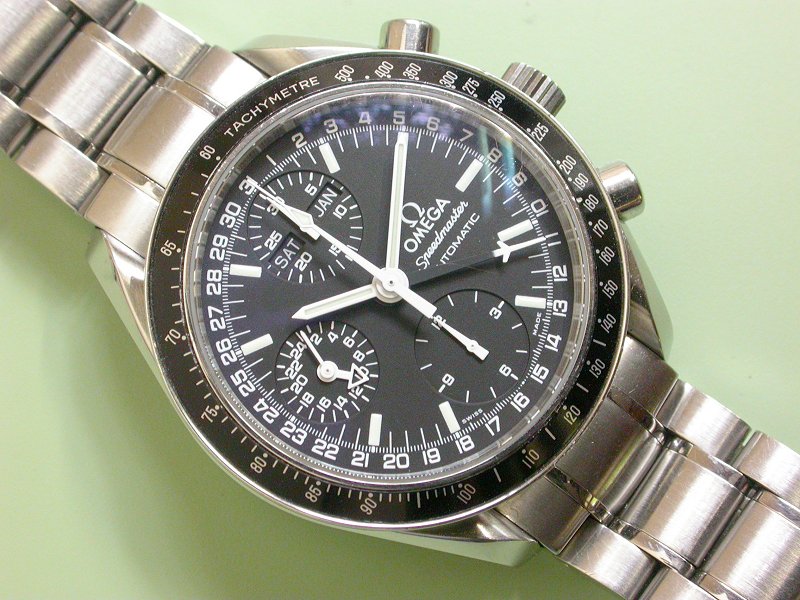
The Omega Cal 1151 is well finished, and looks really nice, decorated with plenty enough Geneva stripes, Perlage and polished bits to soften the heart of even the most hardened watch collector. The movement has 25 jewels, same as the Zeno and all later model 7750's in standard form.
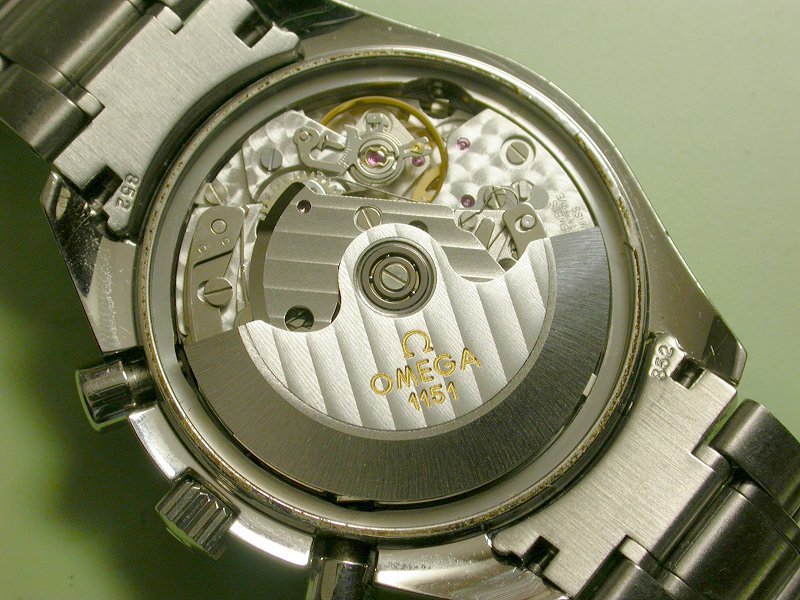
So, this pic below is the final result of my mad foray into triple date watches - two Stainless Steel Wakmann Valjoux 730's, three Gold Filled Wakmann Valjoux 730's, the Zeno monster Valjoux 7751 Moonphase, and the Omega Speedmaster Cal 1151 triple-date. All said and done, I still lean towards the manual-wind Valjoux 730 as being my favorite triple date chronograph movement.
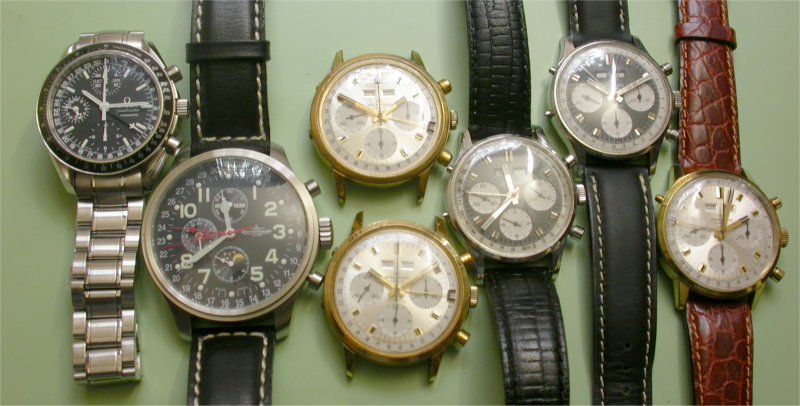
And one last word about the Speedmaster. I have to say I was very unimpressed with the design of the deployant buckle on what is basically a very well made bracelet. After much fiddling around with it, trying to get a quick technique of closing it without needing three hands, I decided that a nice black leather strap was a much better option and looks quite ok too. So, at the moment, I am wearing the Zeno on my left wrist and the Omega on my right. The nurses in the hospital, where I currently await my 5th back surgery, think I am quite strange wearing two watches! I also have A SS Wakmann Valjoux 730 and an Omega Speedsonic on standby in case I need a change. But, as any WIS would know, wearing two watches is a good sign that all is well!
I hoped you enjoyed reading about my experiences with these watches.....
Best Regards, Rob
(December 25th 2005, Wibhavadi Hospital, Bangkok, Thailand.)